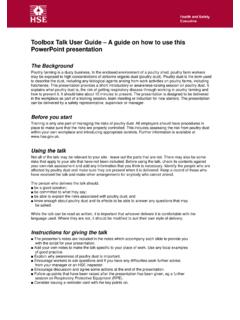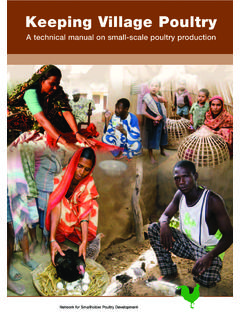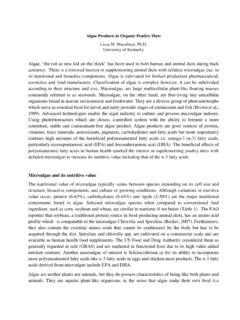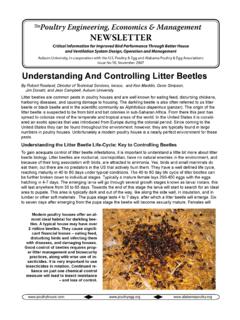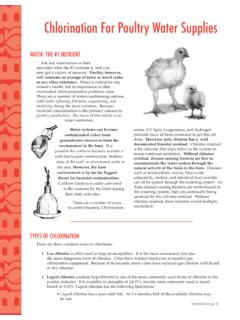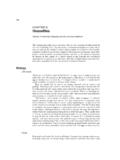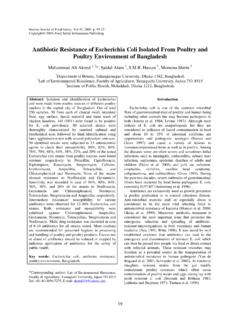Transcription of SMALLHOLDER POULTRY PRODUCTION – …
1 4. SMALLHOLDER POULTRY PRODUCTION SMALLHOLDER POULTRY PRODUCTION . livelihoods , food security . AND SOCIOCULTURAL SIGNIFICANCE. 4. SMALLHOLDER POULTRY PRODUCTION SMALLHOLDER POULTRY PRODUCTION . livelihoods , food security . AND SOCIOCULTURAL SIGNIFICANCE. Kryger, Thomsen, Whyte and M. Dissing Network for SMALLHOLDER POULTRY Development food AND AGRICULTURE ORGANIZATION OF THE UNITED NATIONS. Rome, 2010. Authors Karsten Nelleman Kryger, Karin Anette Thomsen, Michael A. Whyte and M. Dissing prepared the paper as members of the Network for SMALLHOLDER POULTRY Development, Copenhagen, Denmark Recommended Citation FAO. 2010. SMALLHOLDER POULTRY PRODUCTION livelihoods , food security and sociocultural significance, by K. N. Kryger, K. A. Thomsen, M. A. Whyte and M. Dissing. FAO SMALLHOLDER POULTRY PRODUCTION Paper No. 4. Rome. Keywords SMALLHOLDER POULTRY , livelihoods , Gender aspects, Social and Cultural Role The designations employed and the presentations of material in this publication do not imply the expression of any opinion whatsoever on the part of the food and Agriculture Organization of the United Nations concerning the legal status of any country, territory, city or area or its authorities or concerning the delimitations of its frontiers or boundaries.
2 The opinions expressed are solely those of the author and do not constitute in any way the official position of the FAO. All rights reserved. Reproduction and dissemination of material in this information product for educa- tional or other non-commercial purposes are authorized without any prior written permission from the copyright holders provided the source is fullyacknowledged. Reproduction of material in this informa- tion product for resale or other commercial purposes is prohibited without written permission of the copyright holders. Applications for such permission should be addressed to: Chief Publishing Policy and Support Branch Office of Knowledge, Research and Extension FAO. Viale delle Terme di Caracalla, 00153 Rome, Italy or by e-mail to: FAO 2010. iii Contents Preface v SMALLHOLDER POULTRY PRODUCTION livelihoods , food security and sociocultural significance 1.
3 Summary 1. 1. Introduction 1. SMALLHOLDER farming systems and SMALLHOLDER society 2. POULTRY in SMALLHOLDER systems 3. Analytical framework 4. The structure of the paper 7. 2. food security income, consumption and savings 7. Introduction studies on the socio-economics of SMALLHOLDER POULTRY PRODUCTION 7. The structure of POULTRY PRODUCTION 8. Changing structures and opportunities for smallholders 8. Sector 3 - Small scale commercial POULTRY PRODUCTION 10. Sector 4 18. Savings as a way to reduce vulnerability 26. Institutions, structures and processes 28. 3. Social and cultural significance of POULTRY in SMALLHOLDER societies 34. Introduction: SMALLHOLDER POULTRY more than a resource for poverty alleviation 34. Animals and SMALLHOLDER society: small but significant chickens 35. SMALLHOLDER POULTRY keeping: seasonal dynamics and multiple functions 36.
4 POULTRY gifts and feasts: strengthening SMALLHOLDER reciprocity and social networks 40. POULTRY as cultural communication: ritual, sacrifice and symbolism 41. The role of POULTRY in ritual sacrifice and divination rites 41. 4. Gender aspects of SMALLHOLDER POULTRY PRODUCTION 43. Women and POULTRY and exceptions to the rule 44. SMALLHOLDER POULTRY -keeping strategies 46. Gender aspects of POULTRY income and marketing 47. POULTRY as women's social and economic capital ownership, decision-making power and development projects 49. iv 5. Summary and Implications 51. Income and consumption 51. Social capital 54. References 55. Abbreviations 67. v Preface This Working Paper is part of a series that describes the opportunities and limitations of SMALLHOLDER POULTRY PRODUCTION . The major structural changes that have occurred in POULTRY PRODUCTION and marketing in recent decades have lead to a strong and internationally inte- grated POULTRY industry.
5 In developing countries, however, the majority of POULTRY are still kept by smallholders in less intensive systems. The advantages of these systems are the low levels of inputs that they require and the unique products they produce. These systems are practiced by people who have few other options and it is important that they survive as long as they are needed for social reasons, food security and livelihood support. The paper utilizes a Sustainable livelihoods Framework to review how SMALLHOLDER POULTRY contributes to households and livelihoods . It finds that social-capital aspects of SMALLHOLDER POULTRY PRODUCTION have been given little attention in research and or in devel- opment projects. POULTRY has played, and still plays, important social and cultural roles in the life of rural people, not least for building social relations with other villagers.
6 Institu- tional structures are not favourable to SMALLHOLDER POULTRY PRODUCTION . The interventions that could enhance productivity are well recognized, but the animal health services needed to promote these interventions are, in general, poorly developed. Models for developing animal health services for smallholders are also well known, but the regulatory reforms needed are not implemented. We hope this report will provide accurate and useful information to its readers and any feedback is welcome by the author and the Animal PRODUCTION Service (AGAP)1 of the food and Agriculture Organization of the United Nations (FAO). 1 For more information visit the FAO POULTRY website at: or contact: Olaf Thieme Livestock Development Officer Email: food and Agriculture Organization - Animal PRODUCTION and Health Division Viale delle Terme di Caracalla 00153.
7 Rome, Italy 1. SMALLHOLDER POULTRY PRODUCTION livelihoods , food security and sociocultural significance Kryger, Thomsen, Whyte and M. Dissing Network for SMALLHOLDER POULTRY Development Summary SMALLHOLDER POULTRY PRODUCTION is practised by most rural households throughout the developing world; despite the fact that its contribution to livelihoods appears to be of little nominal value when observed by researchers and other outsiders. This paper utilizes a Sus- tainable livelihoods Framework to review how SMALLHOLDER POULTRY contributes to house- holds and livelihoods . The Sustainable livelihoods Framework emphasizes the vulnerability context of rural livelihoods and the need to consider many types of capital in the analysis of livelihoods . The paper finds that social-capital aspects of SMALLHOLDER POULTRY PRODUCTION have been given little attention in research and or in development projects.
8 POULTRY has played, and still plays, important social and cultural roles in the life of rural people, not least for building social relations with other villagers. While income and consumption have been considered the main rationale for keeping village POULTRY , the methodologies applied in identifying the contribution of POULTRY keeping to income and food security does not permit a comparison of findings across the reviewed material. The review confirms the widely recognized contribution of SMALLHOLDER POULTRY keeping to the income and internal household position of women. Institutional structures are not favourable to SMALLHOLDER POULTRY PRODUCTION . The inter- ventions that could enhance productivity are well recognized, but the animal health serv- ices needed to promote these interventions are, in general, poorly developed. Models for developing animal health services for smallholders are also well known, but the regulatory reforms needed are not implemented.
9 The outbreaks of highly pathogenic avian influ- enza (HPAI) resulted in policies and regulations that have significant impact on the future structure of POULTRY PRODUCTION and trade. Although it is too early to assess the long-term effects of HPAI on the POULTRY industry, there are emerging signs of restructuring with a shift away from small-scale commercial PRODUCTION towards larger-scale PRODUCTION . Village PRODUCTION is, however, likely to persist. 1. Introduction This paper is concerned with POULTRY reared outside the ambit of industrial PRODUCTION . POULTRY are widely acknowledged as the livestock of the poor, and POULTRY PRODUCTION is part of most SMALLHOLDER farming systems. Gu ye (2000) writes that 85 percent of rural house- holds in sub-Saharan Africa keep chickens or other types of POULTRY . POULTRY are equally 2 SMALLHOLDER POULTRY PRODUCTION - Opportunities and limitations important to smallholders in Asia (FAO, 2003a; Islam and Jabbar, 2005) and Latin America (Mallia, 1999; Kyvsgaard, 2007).
10 This paper sets out to review the contribution of POULTRY to SMALLHOLDER livelihoods economically, as well as socially and culturally and to SMALLHOLDER household food security . We look both at its direct contribution to family reproduction, in the form of meat and eggs, and at its indirect contribution, when POULTRY are sold or traded and when birds play a role in maintaining social networks and ritual life. SMALLHOLDER farming systems and SMALLHOLDER society Before we address the specific question of SMALLHOLDER POULTRY PRODUCTION we seek to place it in its context, namely the SMALLHOLDER farming system . This term refers to the many diverse forms of PRODUCTION found in SMALLHOLDER societies across the world (Netting, 1993). Usually, the SMALLHOLDER farming system is conceived in terms of what it is not: not capitalist, not large scale and not technology intensive.










